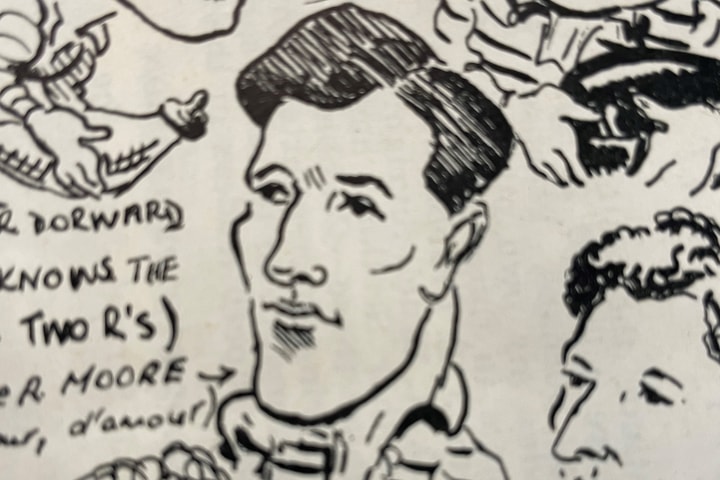
21 November 2025


During the 2015 Rugby World Cup, the flying Welsh wing-three-quarter, John ("Johnny" or "Johnnie") Lewis Williams, was inducted into World Rugby's Hall of Fame, ninety-nine years after his death in the Great War. It was a richly deserved honour. He was, after all, one of the most talented and exciting rugby players to be killed in the war. In his time, he was admired for his "sure tackling, fielding, and kicking, combined with a deceptive turn of speed and, above all, a capital swerve" and was praised as "a great footballer; always a trier and a universal favourite of the crowd".
Johnny played twelve seasons of elite club rugby and, during Wales's first "Golden Era", he won seventeen Welsh caps between 1906 and 1911, averaging a try a match. On the losing side only twice for Wales, he was a prominent member of three Grand Slam winning teams. He also played in two Tests against New Zealand for the 1908 British (Anglo-Welsh) tourists and was the team's leading try scorer. He was born on the 3rd January 1882 in Whitchurch, Cardiff, where he began his rugby career. So well did Johnny take to the game at Whitchurch, he was soon invited to join Newport and he made his First XV debut there whilst still only seventeen. However in 1903-4, after four seasons at Rodney Parade, he switched to his home town club and remained with Cardiff until he retired. Johnny now worked hard at improving his speed and perfecting what became his signature side-step and inward swerve from the touchline and it paid off. He quickly established a dazzling centre/wing partnership with Rhys Gabe, one of the finest centres ever to play for Wales. The Welsh selectors took note. Johnny won his first cap against South Africa in 1906 and was one of the few Welshmen to receive praise after Wales's surprising defeat. A month later, however, in happier circumstances, he demonstrated his devastating swerve by leaving Arthur Marsberg standing when he scored in Cardiff's stunning 17-0 defeat of South Africa. Marsberg, a full-back who was rarely bettered, sportingly acknowledged this feat by immediately shaking Johnny's hand. Two years later, Johnny scored two spectacular tries in Cardiff's 24-8 victory over Australia. He was also regularly on the score sheet for Wales. He twice registered a hat trick against Ireland, in 1907 and in 1910. His tries in the tight victories over Scotland and Ireland proved to be crucial in helping Wales win the first Grand Slam in 1907-8. Johnny was prominent again in 1908-9, when the defeat of Australia was followed by a second successive Grand Slam. In 1910-11, he was still delighting the crowds, as Wales gained their third Grand Slam (and their sixth Triple Crown in eleven years). For the 1911 match in Paris, Johnny was honoured with the Welsh captaincy and celebrated this with a fine try in the 15-0 victory.
He retired from rugby at the end of that season but returned to France under rather different circumstances within a few years. Johnny was a partner in a coal exporting firm in Cardiff but when war broke out he enlisted in the Royal Fusiliers at the age of thirty-four. However, with the Lord Mayor of Cardiff campaigning to raise a battalion bearing the name of the city, Johnny decided to apply for a commission there and was accepted and later promoted to captain. What helped him make up his mind was the number of local rugby players serving in the 16th Battalion (Cardiff City) Welsh Regiment. They included Welsh internationals Bert Winfield, Clem Lewis and Dick Thomas; the Welsh-born but English post-war international Robert Duncan; and many players from Cardiff RFC, Glamorgan Wanderers and Cardiff and District clubs. In particular, Johnny was well acquainted with Fred Smith who later commanded the battalion in France: when Johnny captained Cardiff RFC in 1909-10, Fred had been his vice-captain. Johnny took part in the 38th (Welsh) Division's first major action of the war, the Battle of Mametz Wood. The 16th Welsh and the 11th South Wales Borderers were ordered to make the opening attack on the wood on the 7th July 1916. It was, though, an impossible task. The operation was badly planned and consequently the attacking troops were unable to get within 200 metres of their objective. Waves of men were cut down by heavy machine gun fire, not only from the wood, but also from their right flank. Encouraging his men forward, Johnny ̶ like Dick Thomas ̶ was one of over 300 casualties suffered by the Cardiff City Battalion that ill-fated day. He received a severe shrapnel wound to the left leg and was evacuated to a casualty clearing station some miles behind the front. There his leg was amputated but his condition deteriorated rapidly and on the 12th July 1916 ̶ the day that Mametz Wood was finally cleared of the enemy ̶ "Johnny Bach", the prolific try scorer and "universal favourite" of the Arms Park crowd, sadly succumbed to his wounds. Captain John Lewis Williams is buried in Corbie Communal Cemetery Extension alongside 900 others, most of whom died of wounds during the Battles of the Somme.

About the Author - Gwyn Prescott is a Cardiff based rugby historian and writer. His latest book 'Call Them to Remembrance': The Welsh Rugby Internationals who Died in the Great War is available through publishers St. David's Press and from Amazon.
Follow the World Rugby Museum on Facebook, Twitter and Instagram.